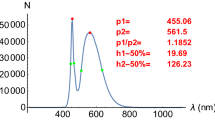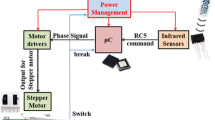Abstract
Female anglerfishes have a lantern-shape luminous organ sprouting from the middle of their heads to lure their prey in the dark deep sea. Inspired by the anglerfish, we designed an electromagnetic anglerfish-shaped millirobot that can receive energy and transform it into light to attract algae cells to specific locations. The small wireless powered robot can receive about 658 mW of power from external energy supply coils, and light LEDs (light-emitting diodes). The wireless power generation and moving control of the robot are analyzed systematically. Transmitting electric energy to smaller scale receivers to endow milli or micro robots with wireless power function is an interesting and promising research direction. With this function, the wireless powered robot is expected to be extensively used at the small scale in the near future, such as to provide electricity to drive microdevices (microgrippers, microsensors, etc.), provide light or heat in small-scale space, stimulate/kill pathological cells in minimally invasive treatment and so on.







Similar content being viewed by others
References
A. Búzás, L. Kelemen, A. Mathesz, L. Oroszi, G. Vizsnyiczai, T. Vicsek, P. Ormos, Light sailboats: Laser driven autonomous microrobots. Appl. Phys. Lett. 101, 737 (2012)
B.L. Cannon, J.F. Hoburg, D.D. Stancil, S.C. Goldstein, Magnetic resonant coupling as a potential means for wireless power transfer to multiple small receivers. IEEE. T. Power. Electr 24, 1819–1825 (2009)
G. Chatzipirpiridis, O. Ergeneman, J. Pokki, F. Ullrich, S. Fusco, J.A. Ortega, K.M. Sivaraman, B.J. Nelson, S. Pané, Electroforming of implantable tubular magnetic microrobots for wireless ophthalmologic applications. Adv. Healthc. Mater 4, 209–214 (2015)
X.Z. Chen, M. Hoop, N. Shamsudhin, T. Huang, B. Özkale, Q. Li, E. Siringil, F. Mushtaq, L. Di Tizio, B.J. Nelson, Hybrid magnetoelectric nanowires for nanorobotic applications: Fabrication, magnetoelectric coupling, and magnetically assisted in vitro targeted drug delivery. Adv. Mater. 29 (2017)
S.E. Chung, X. Dong, M. Sitti, Three-dimensional heterogeneous assembly of coded microgels using an untethered mobile microgripper. Lab Chip 15(7), 1667–1676 (2015)
B. Dai, J. Wang, Z. Xiong, X. Zhan, W. Dai, C.C. Li, S.P. Feng, J. Tang, Programmable artificial phototactic microswimmer. Nat. Nanotechnol. 11, 1087 (2016)
O.P. Ernst, P.A.S. Murcia, P. Daldrop, S.P. Tsunoda, S. Kateriya, P. Hegemann, Photoactivation of channelrhodopsin. J. Biol. Chem. 283, 1637–1643 (2008)
Finkenzeller, K., 2010. RFID Handbook: Fundamentals and Applications in Contactless Smart Cards, Radio Frequency Identification and near-Field Communication. John Wiley & Sons
K. Foster, R. Smyth, Light antennas in phototactic algae. Microbiol. Rev. 1980(44), 572–630 (1980)
H.W. Huang, M.S. Sakar, A.J. Petruska, S. Pané, B.J. Nelson, Soft micromachines with programmable motility and morphology. Nat. Commun. 7, 12263 (2016)
S. Jeon, G. Jang, H. Choi, S. Park, J. Park, Magnetic navigation system for the precise helical and translational motions of a microrobot in human blood vessels. J. Appl. Phys. 111, 55 (2012)
Jiles, D., 2015. Introduction to magnetism and magnetic materials. CRC press, Boca Raton, FL, USA
B. Kherzi, M. Pumera, Self-propelled autonomous nanomotors meet microfluidics. Nanoscale 8, 17415 (2006)
S. Martel, C.C. Tremblay, S. Ngakeng, G. Langlois, Controlled manipulation and actuation of micro-objects with magnetotactic bacteria. Appl. Phys. Lett. 89, 257–681 (2006)
S. Martel, O. Felfoul, J.B. Mathieu, A. Chanu, S. Tamaz, M. Mohammadi, M. Mankiewicz, N. Tabatabaei, MRI-based medical nanorobotic platform for the control of magnetic nanoparticles and flagellated bacteria for target interventions in human capillaries. Int. J. Robot. Res. 28, 1169 (2009)
R. Mhanna, F. Qiu, L. Zhang, Y. Ding, K. Sugihara, M. Zenobi-Wong, B.J. Nelson, Artificial bacterial flagella for remote-controlled targeted single-cell drug delivery. Small 10, 1953–1957 (2014)
W.T. O'Day, H.R. Fernandez, Aristostomias scintillans (Malacosteidae): A deep-sea fish with visual pigments apparently adapted to its own bioluminescence. Vis. Res. 14, 545–550 (1974)
N. Okita, N. Isogai, M. Hirono, R. Kamiya, K. Yoshimura, Phototactic activity in Chlamydomonas 'non-phototactic' mutants deficient in Ca2+−dependent control of flagellar dominance or in inner-arm dynein. J. Cell Sci. 118, 529–530 (2005)
S. Palagi, A.G. Mark, S.Y. Reigh, K. Melde, T. Qiu, H. Zeng, C. Parmeggiani, D. Martella, A. Sanchez-Castillo, N. Kapernaum, Structured light enables biomimetic swimming and versatile locomotion of photoresponsive soft microrobots. Nat. Mater. 15, 647 (2016)
Pietsch, T. W., Kenaley, C. P., 2007. Ceratioidei. Seadevils, Devilfishes, Deep-sea Anglerfishes. Version 02 October 2007 (under construction). in The Tree of Life Web Project, http://tolweb.org/Ceratioidei/22000/2007.10.02 Accessed 29 January 2019
J. Pokki, O. Ergeneman, G. Chatzipirpiridis, T. Lühmann, J. Sort, E. Pellicer, S.A. Pot, B.M. Spiess, S. Pane, B.J. Nelson, Protective coatings for intraocular wirelessly controlled microrobots for implantation: Corrosion, cell culture, and in vivo animal tests. J. Biomed. Mater. Res. B 105, 836–845 (2017)
Ross, P., 2007. Extraordinary animals: an encyclopedia of curious and unusual animals. Greenwood Publishing Group, Santa Barbara, CA, USA
G.C. Rump, Kunst kontra Technik? Wechselwirkungen zwischen Kunst, Naturwissenschaft und Technik by Herbert W. Franke. Leonardo 12, 74–75 (1979)
A. Servant, F. Qiu, M. Mazza, K. Kostarelos, B.J. Nelson, Controlled in vivo swimming of a swarm of bacteria-like microrobotic flagella. Adv. Mater. 27, 2981–2988 (2015)
X. Shen, C. Viney, E.R. Johnson, C. Wang, J.Q. Lu, Large negative thermal expansion of a polymer driven by a submolecular conformational change. Nat. Chem. 5, 1035 (2013)
S. Tottori, L. Zhang, F. Qiu, K.K. Krawczyk, A. Franco-Obregón, B.J. Nelson, Magnetic helical micromachines: Fabrication, controlled swimming, and cargo transport. Adv. Mater. 24, 811 (2012)
Wang, G., Liu, W., Sivaprakasam, M., Humayun, M. S., Weiland, J. D., 2005. Power supply topologies for biphasic stimulation in inductively powered implants. In Power supply topologies for biphasic stimulation in inductively powered implants, Circuits and Systems, 2005. ISCAS 2005. IEEE International Symposium on, IEEE, pp 2743–2746
D.B. Weibel, P. Garstecki, D. Ryan, W.R. DiLuzio, M. Mayer, J.E. Seto, G.M. Whitesides, Microoxen: Microorganisms to move microscale loads. P. Natl. Acad. Sci. USA 102, 11963–11967 (2005)
Whelan, P. M., Hodgson, M. J., 1987. Essential principles of physics. J. W. Arrowmith ltd London, LN, UK
S. Xie, N. Jiao, S. Tung, L. Liu, Controlled regular locomotion of algae cell microrobots. Biomed. Microdevices 18, 47 (2016)
S. Xie, X. Wang, N. Jiao, S. Tung, L. Liu, Programmable micrometer-sized motor array based on live cells. Lab Chip 17, 2046 (2017)
H. Xu, M. Medina-Sánchez, V. Magdanz, L. Schwarz, F. Hebenstreit, O.G. Schmidt, Sperm-hybrid micromotor for targeted drug delivery. ACS Nano (1) (2017)
X. Yan, Q. Zhou, M. Vincent, Y. Deng, J. Yu, J. Xu, T. Xu, T. Tang, L. Bian, Y.-X.J. Wang, K. Kostarelos, L. Zhang, Multifunctional biohybrid magnetite microrobots for imaging-guided therapy. Sci. Robot 2, 1155 (2017)
C. Zhang, S. Xie, W. Wang, N. Xi, Y. Wang, L. Liu, Bio-syncretic tweezers actuated by microorganisms: Modeling and analysis. Soft Matter 12, 7485 (2016)
Acknowledgements
This paper is supported by National Natural Science Foundation of China (Grant No. 61573339) and the CAS/SAFEA International Partnership Program for Creative Research Teams.
Author information
Authors and Affiliations
Corresponding author
Additional information
Publisher’s note
Springer Nature remains neutral with regard to jurisdictional claims in published maps and institutional affiliations.
Electronic supplementary material
(WMV 12307 kb)
(WMV 9313 kb)
Rights and permissions
About this article
Cite this article
Wang, J., Jiao, N., Wang, X. et al. An electromagnetic anglerfish-shaped millirobot with wireless power generation. Biomed Microdevices 21, 15 (2019). https://doi.org/10.1007/s10544-019-0361-5
Published:
DOI: https://doi.org/10.1007/s10544-019-0361-5




